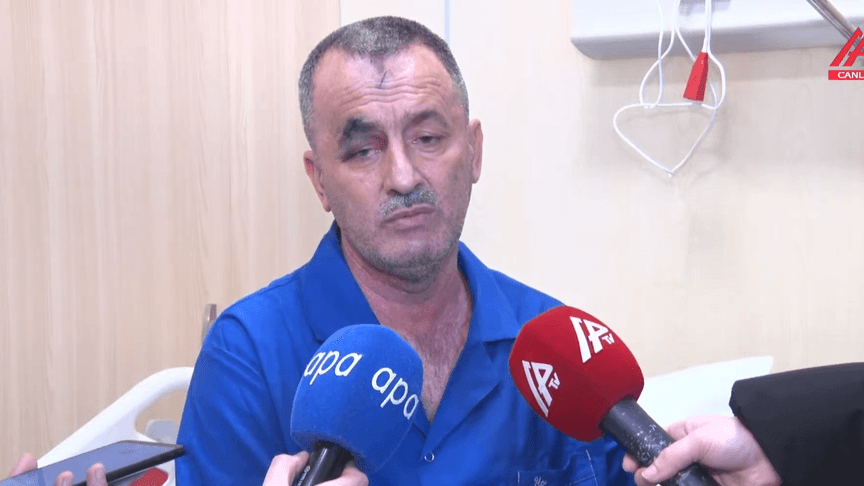"I thought we were all dead." A flight attendant who survived the plane crash in Aktau shared details about the aviation disaster.

Zulfugar Asadov told APA TV, as quoted by Media.Az.
He mentioned that an emergency situation on board the aircraft occurred even before the emergency landing during the flight to Grozny. As they were approaching for landing, the crew noticed that the airport was enveloped in "very thick fog."
The captain initiated a descent, but due to poor visibility, three attempts to land the aircraft were unsuccessful.
At that point, the plane decided to head to the nearest airport. “But at that moment, a strange sound was heard from outside the aircraft. I immediately went to the cabin with my colleague Aidan Ragimli. We saw that panic had started among the passengers,” recalled Asadov.
The passengers were calmed down and asked to fasten their seatbelts. “At that moment, as a result of a strike from the outside of the aircraft, I received a cut on my hand and bandaged it tightly. Aidan helped me. We continued the flight. I told Aidan to sit in her place while I took mine. After that, the crew commander decided to change the landing site from the water surface to land,” the man recounted.
He explained that the commander was forced to make an emergency landing because the aircraft's engine had malfunctioned. Doing so over water would have been dangerous: the plane would have been torn apart. As the flight attendant noted, both the crew and passengers acted according to the instructions.
Asadov denied information from several Russian media outlets that a gas cylinder exploded during the flight: “That is not true. If anything had happened to the oxygen cylinder, the aircraft would have been torn apart. The information that a gas cylinder was brought on board is also false. […] This tragic situation arose due to external influences on the aircraft.”
If we disregard the travel time from Baku to Grozny, he stated that the flight lasted about an hour. The pilots were trying to maintain the aircraft's altitude.
According to his feelings, the front landing gear of the aircraft touched the ground first. If the aircraft had touched down completely right away, perhaps no one would have survived, the man added.
“When the front landing gear touched the ground, the aircraft was torn in two, and the front cockpit detached. I was conscious, despite bleeding, but it was very hard to breathe. Aidan and I lay by the door; I tried to open it. After air entered the remaining part of the cabin, it became easier. We started helping the passengers and getting them out of the aircraft. A rescue team was waiting for us outside,” he recounted.
Asadov emphasized that he did not hope to survive after the plane crash: “When we hit the ground, I thought we were already dead. Because there was a strong shaking. It felt like my whole body was shaking. I did not expect to survive. Thank God, I survived. It is unfortunate that the crew members and other passengers were not so lucky. We survived thanks to the heroism of our crew commander and the second pilot.”
What happened to the aircraft?
On December 25, the Azerbaijan Airlines plane was operating a flight from the capital of Azerbaijan, Baku, to the Russian city of Grozny (Chechen Republic). However, after changing its route several times, it crashed near Kazakhstan's Aktau. As a result, 38 people died on board.
The Russian aviation authority initially claimed that the accident occurred due to a bird strike. According to Grozny airport data, the aircraft was redirected to Makhachkala due to fog, and then from there to Aktau. However, analysts consider these versions questionable.
Although there was indeed fog over the region that morning, Grozny airport was temporarily closed due to the declaration of a "Carpet" plan in the context of drone attacks. The monitoring portal Flightradar24 stated that after approaching the Grozny area, the flight path data of the aircraft was distorted—likely due to GPS signal jamming and data replacement.
Additionally, footage of the tail section of the aircraft circulated on social media—on the fuselage, there were marks resembling damage from projectiles. OSINT analysts claimed that these looked like traces from the Pantsir air defense system. Other bloggers suggested that these could have been damage from stones during the crash.
Kazakh media, citing the health management of the Mangystau region, reported that there was an explosion on board. Survivors of the crash also mentioned an explosion. The police have opened a criminal case regarding the plane crash.
In Russia and Kazakhstan, there have been calls not to rush to conclusions. Meanwhile, according to media reports, preliminary investigations in Azerbaijan indicate that the cause of the crash was a Russian missile, which may have been launched to counter drone attacks. This is also asserted by the head of the GUR MOU Kirill Budanov.
According to Reuters, Azerbaijan does not assert that the plane was shot down intentionally but expects "acknowledgments" from the Russian side.